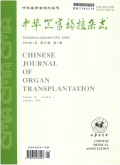不同免疫诱导治疗方案对活体亲属ABO血型不相容肾移植受者术后早期临床结局的影响
Effect of different immune induction therapies on early clinical outcomes of ABO-incompatible kidney transplantation recipients of living relative donor
摘要目的:比较活体亲属ABO血型不相容肾移植(ABO-incompatible kidney transplantation,ABOi-KT)受者应用不同种类免疫诱导方案的早期(术后6个月内)临床结局。方法:回顾性分析2018年6月至2022年9月在华中科技大学同济医学院附属同济医院器官移植研究所行活体亲属ABOi-KT 41例受者的临床资料。其中,采用抗人T细胞猪免疫球蛋白(anti-human T lymphocyte porcine immunoglobin,pATG)行诱导治疗者13例(pATG组),采用白细胞介素-2受体拮抗剂者19例(巴利昔单抗组),采用兔抗人胸腺细胞免疫球蛋白(rabbit anti-human thymocyte immunoglobulin,rATG)诱导者9例(rATG组)。统计并分析3组受者的年龄、性别、体重指数(body mass index,BMI)、透析方式、透析时间、左右供肾、血型抗体处理次数、利妥昔单抗使用剂量、基础血型抗体效价(IgG和IgM)以及受者供体的性别和BMI等方面的差异。单因素方差分析比较3组受者预处理前和移植术后6个月内的淋巴细胞计数评估受者免疫状态;单因素方差分析比较3组受者移植术后6个月内的血清肌酐、估算肾小球滤过率(estimated glomerular filtration rate,eGFR)、血清尿素氮水平评估移植肾功能。比较3组受者术后移植肾功能延迟恢复(delayed graft function,DGF)、术后6个月内急性排斥反应(acute rejection,AR)和感染的发生情况。结果:基线资料方面,除pATG组供者年龄[(60.23±6.10)岁]较巴利昔单抗组[(51.95±6.97)岁]大,差异有统计学意义( P=0.002)外,3组其余参数比较,差异均无统计学意义( P值均>0.05)。pATG组受者术后第1、3、7、10、14天淋巴细胞计数分别为(0.17±0.07)×10 9/L、(0.27±0.14)×10 9/L、(0.85±0.40)×10 9/L、(1.05±0.56)×10 9/L、(1.10±0.56)×10 9/L,rATG组分别为(0.69±0.04)×10 9/L、(0.18±0.21)×10 9/L、(0.57±0.44)×10 9/L、(0.67±0.45)×10 9/L、(0.81±0.46)×10 9/L,均较巴利昔单抗组[(0.46±0.18)×10 9/L、(0.67±0.26)×10 9/L、(1.29±0.48)×10 9/L、(1.56±0.49)×10 9/L、(1.75±0.53)×10 9/L]低,差异均有统计学意义( P值均<0.05);在预处理前和术后21 d后3组淋巴细胞绝对计数比较差异无统计学意义( P值均>0.05)。在移植术后第1周、第2周、1个月、3个月及6个月的血清肌酐和血清尿素氮水平的差异无统计学意义( P>0.05);rATG组术后1个月、3个月时的eGFR分别为(47.24±14.51)ml·min -1·(1.73 m 2) -1和(49.94±14.31)ml·min -1·(1.73 m 2) -1,较巴利昔单抗组(67.36±21.60)ml·min -1·(1.73 m 2) -1和(65.00±14.67)ml·min -1·(1.73 m 2) -1低,差异有统计学意义( P<0.05);但3组术后1周、2周及6个月时的eGFR水平差异无统计学意义( P>0.05)。3组术后1周内DGF均发生1例;术后6个月内,pATG组、巴利昔单抗组、rATG组分别发生AR 2例、2例和1例,分别发生感染4例、7例和3例。 结论:单中心有限的样本观察发现,对于使用pATG、巴利昔单抗和rATG进行免疫诱导治疗的ABOi-KT受者,移植术后早期的DGF差异无统计学意义。3组均有DGF、AR和感染发生,但组间差异不大。
更多相关知识
abstractsObjective:We employ different regimens of induction therapy in living donor ABO-incompatible kidney transplantation(ABOi-KT) recipients to compare their clinical outcomes during 6 months post-KT.Methods:A retrospective analysis was conducted for the relevant clinical data of 41 ABOi-KT recipients from June 2018 to September 2022.Thirteen recipients on induction therapy of anti-human T lymphocyte porcine immunoglobin(pATG)were enrolled in pATG group; 19 recipients on induction therapy of basiliximab in basiliximab group; 9 recipients on induction therapy of rabbit anti-human thymocyte immunoglobulin(rATG)in rATG group.Differences in age, gender, body mass index(BMI), dialysis modality/duration, sideness of donor kidney, frequency of blood group antibody treatment, dose of rituximab, basic blood group antibody titers of IgG/IgM, and the gender and BMI of recipient's donor were compared for three groups.Immune status was assessed by comparing absolute lymphocyte count before pre-treatment and within 6 months post-KT in recipients under different induction regimens among 3 groups by one-way analysis of variance.Transplant kidney function was assessed by comparing the levels of serum creatinine, estimated glomerular filtration rate(eGFR)and serum urea nitrogen using one-way analysis of variance.The incidence of delayed graft function(DGF), acute rejection(AR)and infection was compared among three groups.Results:Regarding baseline profiles, except for donor age pATG group[(60.23±6.10)years]versus basiliximab group[(51.95±6.97)years]was statistically significant( P=0.002), the differences in the remaining parameters were not statistically significant among three groups(all P>0.05). At Day 1/3/7/10/14 post-KT, absolute lymphocyte counts were(0.17±0.07)×10 9/L, (0.27±0.14)×10 9/L, (0.85±0.40)×10 9/L, (1.05±0.56)×10 9/L and(1.10±0.56)×10 9/L in pATG group and(0.69±0.04)×10 9/L, (0.18±0.21)×10 9/L, (0.57±0.44)×10 9/L, (0.67±0.45)×10 9/L and(0.81±0.46)×10 9/L in rATG group respectively.They were all higher than those in basiliximab group[(0.46±0.18)×10 9/L, (0.67±0.26)×10 9/L, (1.29±0.48)×10 9/L, (1.56±0.49)×10 9/L, (1.75±0.53)×10 9/L]and the differences were statistically significant(all P<0.05). No statistically significant difference existed in absolute lymphocyte count among 3 groups before pre-treatment and after Day 21 post-KT(all P>0.05). At Week 1/2/4/12/24 post-KT, the differences in serum levels of creatinine and urea nitrogen were not statistically significant( P>0.05). At Month 1/3 post-KT, eGFR was(47.24±14.51)and(49.94±14.31)ml·min -1·(1.73 2) -1 in rATG group and they were lower than(67.36±21.60)and(65.00±14.67)ml·min -1·(1.73 2) -1 in basiliximab group with a statistically significant difference( P<0.05). However, at Week 1/2/24 post-KT, no statistically significant difference existed in eGFR among 3 groups( P>0.05). In ATG, basiliximab and rATG groups, DGF(1 case, 1 case, 1 case), AR(2 cases, 2 cases, 1 case)and infection(4 cases, 7 cases, 3 cases)occurred during 6 months post-KT. Conclusions:Through a limited sample of single centers, no statistically significant difference existed in graft function recovery for ABOi-KT recipients on induction therapies of pATG, basiliximab and rATG.And DGF, AR and infections occurred in all three groups.However, there were little inter-group differences.
More相关知识
- 浏览0
- 被引0
- 下载0


相似文献
- 中文期刊
- 外文期刊
- 学位论文
- 会议论文



 换一批
换一批 换一批
换一批



